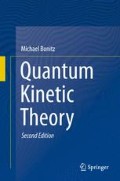Abstract
This is the first chapter where we discuss correlation effects in nonequilibrium. Here a basic discussion of the relevant time scales is given, starting from the shortest times (time scale \(\tau _{cor}\) of the formation of pair correlations), over the single-particle relaxation scale to the macroscopic scale of hydrodynamic quantities. The short times are crucial in the context of ultrafast excitation of many-body systems, so a key requirement for the theory is its validity on short times.
Access this chapter
Tax calculation will be finalised at checkout
Purchases are for personal use only
Notes
- 1.
- 2.
Obviously, in general, there is no separation of the excitation and the relaxation phase.
- 3.
In case of multiple scattering processes “\(\alpha \)”, \(t_\mathrm{rel}=\text{ min }_{\alpha } \{t_\mathrm{rel}^{(\alpha )}\}\).
- 4.
Substantial differences can be expected only for small N. Possible exceptions are long–living large–scale fluctuations, such as occur in the vicinity of phase transitions, or bound state correlations, which are not considered here, see e.g. [72].
- 5.
This is called Bogolyubov’s “functional hypothesis” [76], cf. also [135].
- 6.
This is true only for weakly correlated systems.
- 7.
n and T, and thus also \(t_\mathrm{rel}\) may be space and time dependent themselves, but on a much larger scale compared to \(t_\mathrm{rel}\), corresponding to the hydrodynamics stage, see Table 5.1.
- 8.
In fact, quantum kinetic theory allows to verify this assumption and to provide a microscopic result for \(t_\mathrm{rel}\). The relaxation time+\(t_\mathrm{rel,a}\) of particle species “a” is calculated from the collision rates \(\nu \) of all relevant scattering processes “\(\gamma \)”, \(t^{-1}_\mathrm{rel,a}=\sum _{b \gamma } \nu ^{(\gamma )}_{ab}\) which are taken from experiment or are derived from kinetic theory, e.g. [67].
- 9.
Of course, all limitations of the relaxation time approximation apply here too. Nevertheless, with a reasonable choice of \(g^{EQ}\) and \(\tau _\mathrm{cor}\), very good quantitative results may be achieved [245].
- 10.
In cases where, before action of the external excitation \(\mathcal{U}\), the system contains only a very low particle density, e.g. in nonmetallic solids at low temperature, \(g_0\approx 0\).
- 11.
Notice that certain types of initial correlations do not decay, for example those which correspond to bound states or large scale fluctuations, which have to be treated separately [72, 133].
Author information
Authors and Affiliations
Corresponding author
Rights and permissions
Copyright information
© 2016 Springer International Publishing Switzerland
About this chapter
Cite this chapter
Bonitz, M. (2016). Correlations and Their Dynamics. In: Quantum Kinetic Theory. Springer, Cham. https://doi.org/10.1007/978-3-319-24121-0_5
Download citation
DOI: https://doi.org/10.1007/978-3-319-24121-0_5
Published:
Publisher Name: Springer, Cham
Print ISBN: 978-3-319-24119-7
Online ISBN: 978-3-319-24121-0
eBook Packages: Physics and AstronomyPhysics and Astronomy (R0)

